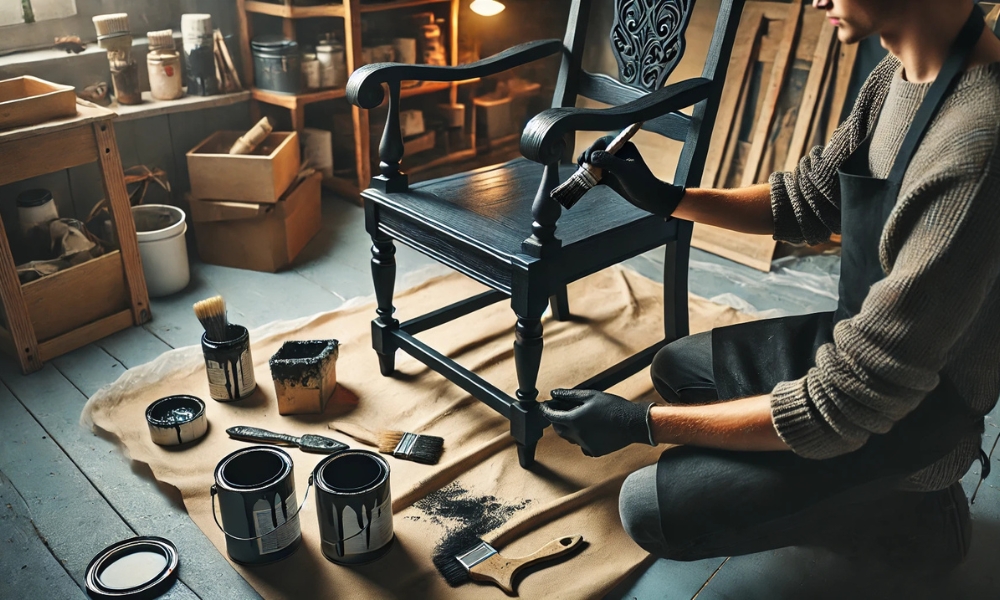Wood chairs are a classic and functional addition to any space, but sometimes they need a facelift to match your evolving décor or personal taste. Paint wood chairs black is a timeless choice that can add elegance, sophistication, or even a modern edge to your furniture. With the right techniques and materials, you can achieve a professional-looking finish that lasts for years. This comprehensive guide will walk you through each step of the process, ensuring you get the results you want.
Why Choose Black For Wood Chairs?
Choosing black for wood chairs is a timeless decision that blends functionality with style. The versatility of black allows it to seamlessly integrate into any decor, whether modern, rustic, or traditional, making it a go-to color for interior design. Black adds an air of elegance, transforming even the simplest chair into a chic statement piece. Additionally, black paint, when paired with a durable finish, conceals minor scratches and imperfections far better than lighter hues, ensuring the chairs maintain their polished look over time. This combination of practicality and sophistication makes black a perfect choice for Clean Wood Adirondack Chairs.
Tools And Materials You’ll Need
Before starting, gather all the necessary tools and materials to ensure a smooth painting process. Here’s what you’ll need:
Tools:
- Sandpaper (120-grit and 220-grit)
- Tack cloth or microfiber cloth
- Painter’s tape
- Drop cloth or plastic sheeting
- Paintbrush (angled and flat)
- Foam roller (optional)
- Screwdriver (for disassembling chairs)
Materials:
- Wood filler (if needed)
- Black wood paint (matte, satin, or glossy, depending on your preference)
- Primer (preferably stain-blocking)
- Clear polyurethane or topcoat (for durability)
- Cleaning solution (mild soap and water or TSP)
- Wood conditioner (for bare wood)
Step-By-Step Guide To Painting Wood Chairs Black
1. Prepare Your Workspace

Before painting, it’s crucial to prepare your workspace to ensure a smooth and hassle-free process. Select a well-ventilated area to minimize exposure to fumes and make the experience safer. Protect your floors and nearby surfaces by laying down a drop cloth or plastic sheeting to catch any spills or drips. Good lighting is also essential, as it helps you identify any missed spots or uneven coverage, ensuring a flawless finish. Proper preparation creates a clean, organized environment, making the painting process more efficient and enjoyable.
2. Clean The Chairs

Cleaning The Chairs thoroughly is a vital step to ensure the paint adheres smoothly and lasts longer. Start by removing any dirt, grease, or old polish using a mild soap and water solution or a more robust cleaner like TSP for a deeper cleanse. Pay attention to crevices and corners where buildup can hide. After cleaning, allow the chairs to dry completely to avoid trapping moisture under the paint, which could lead to peeling or an uneven finish. A clean surface sets the foundation for a professional-quality paint job.
3. Disassemble The Chairs

Disassembling the chairs is an important step to achieve a precise and even paint finish. If your chairs have removable parts, such as cushions, spindles, or hardware, use a screwdriver or appropriate tools to carefully take them apart. This allows you to access hard-to-reach areas and ensures that each component is painted thoroughly without obstruction. Additionally, painting the parts separately reduces the risk of drips or uneven coverage, giving your chairs a clean, professional look when reassembled.
4. Inspect And Repair The Surface

Before painting, inspect the chairs carefully for any cracks, dents, or scratches that could affect the final look. Use a quality wood filler to repair these imperfections, applying it with a putty knife and smoothing it out for an even surface. Allow the filler to dry completely, as this ensures it bonds properly to the wood. Once dried, sand the repaired areas until they are flush with the surface, creating a seamless finish. Taking the time to repair and smooth the chairs will ensure a polished, professional result after painting.
5. Sand The Chairs

Sanding The Chairs is essential for ensuring a smooth, paint-ready surface and promoting better adhesion. Begin with 120-grit sandpaper to strip away the old finish and roughen the surface, providing a good base for the paint. Once the old finish is removed, switch to 220-grit sandpaper to refine the surface and achieve a silky smooth texture. After sanding, thoroughly wipe down the chairs with a tack cloth to remove all dust and debris, ensuring a clean surface that allows the paint to glide on evenly and adhere properly.
6. Apply Primer

Applying primer is a crucial step to ensure a durable and flawless paint finish while preventing stains or tannins from bleeding through. Opt for a stain-blocking primer, particularly for woods like oak or mahogany, which are prone to discoloration. Use a brush to carefully coat detailed areas and a foam roller for larger, flat surfaces, ensuring even coverage. Allow the primer to dry completely according to the manufacturer’s instructions. Once dry, lightly sand the surface with 220-grit sandpaper to create an ultra-smooth base for the paint to adhere seamlessly.
7. Choose The Right Paint

Choosing the right paint is key to achieving the desired look and durability for your wood chairs. Acrylic paint is a popular choice as it’s water-based, easy to clean up, and dries quickly, making it ideal for most projects. Chalk paint is another excellent option, offering a trendy matte, vintage-style finish and requiring minimal prep work. For a more durable and rich finish, consider oil-based paint, which is long-lasting but comes with a longer drying time. Selecting the right paint type ensures your chairs not only look great but also withstand regular use.
8. Paint The Chairs

Painting the chairs is where your project comes to life. Start by applying the first coat of black paint, using a brush to carefully cover intricate details and corners. For larger, flat areas, a foam roller is ideal for achieving a streak-free finish. Work with thin, even coats to prevent drips and ensure smooth application. Allow the first coat to dry completely, following the drying times indicated on the paint label. Lightly sand the surface with 220-grit sandpaper between coats to achieve a polished, smooth texture. Apply a second coat for full, even coverage, repeating the sanding process and adding additional coats as needed for a flawless, professional finish.and additional coats if necessary.
9. Apply A Protective Topcoat
Applying a protective topcoat is the final step to seal the paint, enhance durability, and give your chairs a polished look. Opt for a clear polyurethane topcoat in your preferred finish—matte for a subtle look, satin for a soft sheen, or glossy for a high-shine effect. Use a clean brush or foam applicator to apply thin, even layers, ensuring smooth coverage without drips. Allow each coat to dry thoroughly before applying the next, following the manufacturer’s recommendations. For maximum protection and a long-lasting finish, apply at least two coats, ensuring your chairs remain beautiful and resilient over time.
10. Reassemble The Chairs
Reassembling the chairs is the final step to complete your project. Once the paint and protective topcoat are fully dry, carefully reattach any parts you had disassembled, such as cushions, spindles, or hardware. Use the appropriate tools to tighten screws or fasteners securely, ensuring the chairs are stable and ready for use. Take a moment to inspect the finished piece, making any final adjustments to guarantee everything is aligned and in place. Your beautifully painted chairs are now ready to enhance your space!
Tips For A Flawless Finish
Achieving a flawless finish requires careful attention to detail and patience. Allow each coat of primer, paint, and topcoat to dry completely before moving to the next step to prevent smudging or peeling. Always test your chosen paint and topcoat on a small, hidden area to ensure they work well together and deliver the look you want. For best results, paint in a low-humidity environment, as excessive moisture can interfere with drying and adhesion. Finally, apply thin, even coats instead of one thick layer; working in layers ensures a smooth, professional-quality finish that lasts.
Common Mistakes To Avoid
Avoiding common mistakes is crucial for a successful painting project. Skipping the sanding step can result in uneven paint and poor adhesion, so take the time to prep the surface properly. Rushing through drying times is another pitfall; applying additional coats before the previous one has dried can lead to peeling, bubbling, or a messy finish. Finally, don’t neglect the protective topcoat—this vital step shields the paint from scratches and wear, ensuring your chairs maintain their beauty and durability over time. Patience and thoroughness are key to avoiding these mistakes.
Maintaining Your Black Wood Chairs
Maintaining your black wood chairs ensures they stay as striking as the day you painted them. Regularly wipe them with a damp, soft cloth to remove dust and dirt, preserving their sleek appearance. Avoid using abrasive cleaners or harsh chemicals, as these can scratch or dull the finish. For minor scratches or chips, use leftover paint to touch up the affected areas, keeping the chairs looking seamless and polished. With these simple maintenance tips, your black wood chairs will remain a stylish addition to your space for years to come.
Conclusion
Painting wood chairs black is a simple yet impactful way to breathe new life into your furniture and enhance your decor. By following this guide, with its emphasis on careful preparation, quality materials, and step-by-step techniques, you can achieve a flawless, professional finish that looks store-bought. Whether it’s revitalizing a vintage treasure or giving your dining room a chic upgrade, this DIY project offers both satisfaction and style. So, grab your supplies, channel your creativity, and transform your chairs into stunning black statement pieces that will impress everyone who sees them!


